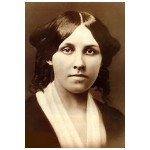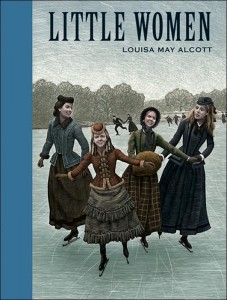
I mentioned last week that Louisa May Alcott seems like an old friend, particularly in her incarnation as the fictional Jo March of Little Women. If you’ve read that book you won’t be surprised to learn that Louisa was the rebel of her family, a tomboy who loved climbing trees and tramping through the woods. She was the second of four daughters, a tall and handsome girl with thick, chestnut-colored hair.
Growing up in Boston and in Concord, Louisa was educated largely by her father (the oh-so-eccentric Bronson Alcott), but was also a student of Henry David Thoreau during the time he ran a school in Concord. She was deeply influenced as well by Emerson, who took an interest in her and allowed her the use of his extensive library.
Intelligent and imaginative, Louisa developed a passion for writing at a young age. Some of her first writing efforts were plays she wrote for her and her sisters to perform (she herself took the part of villains). As a young adult, she was determined to help the family escape their grinding poverty. She moved to Boston and, after trying a teaching career, turned to publishing stories and poetry in popular magazines. She also wrote sensational thrillers under the pseudonym A.M. Barnard, books with titles such as A Long Fatal Love Chase and Pauline’s Passion and Punishment. Even the small amounts of money she was able to send home made a difference to the struggling Alcott family.
In 1857 she moved back to Concord to settle in Orchard House with her family. Her literary novel Moods was published in 1860, but garnered limited attention. An ardent abolitionist, two years later Louisa went to Washington, DC, to work as a nurse for wounded Civil War soldiers. After six weeks she became severely ill and was treated with mercury, a common remedy of the time but one that likely played a major role in the ill health that plagued her for much of the rest of her life. Her book Hospital Sketches was published in 1863 and is based on the letters she wrote home while working as a nurse.
While Louisa had achieved modest success in her writing, it wasn’t until her publisher suggested that she write “a book for girls,” that her literary fortunes changed. She resisted the idea at first, for she wanted to be a serious literary writer, but in 1868 she began work on a children’s story, sitting at a little half-moon shaped desk constructed by her father in her bedroom at Orchard House. Her childhood in Concord provided the raw material for Little Women—though in a fictionalized, sanitized form (no mention of the failed commune Fruitlands, for example, and many of the most painful aspects of her childhood were recalled with a rosy glow). Much of its action is set at Hillside, the home near Orchard House where the Alcott family had once lived and where Nathaniel Hawthorne would later reside.
 With Little Women, Louisa hit gold. The book was an immediate popular success and would become one of the best-selling books of all time. Little Women is significant in part because of the nature of its heroine, Jo March. Children’s literature up to that point was populated by little-goodie-two-shoes, idealized creatures designed to impart moral lessons to readers. Jo March, in contrast, is headstrong, quick to anger, outspoken, and a rebel.
With Little Women, Louisa hit gold. The book was an immediate popular success and would become one of the best-selling books of all time. Little Women is significant in part because of the nature of its heroine, Jo March. Children’s literature up to that point was populated by little-goodie-two-shoes, idealized creatures designed to impart moral lessons to readers. Jo March, in contrast, is headstrong, quick to anger, outspoken, and a rebel.
Little Women also blazed a new trail in other ways. In American Bloomsbury, Susan Cheever writes: “Without intending to, Louisa May Alcott invented a new way to write about the ordinary lives of women, and to tell stories that are usually heard in kitchens or bedrooms. She made literature out of the kind of conversations women have while doing the dishes together or taking care of their children. It was in Little Women that I learned that domestic details can be the subject of art, that small things in a woman’s life—cooking, the trimming of a dress or hat, quiet talk—can be just as important a subject as a great whale or a scarlet letter…even though it’s a novel, in tone and voice it is the precursor of the modern memoir—the book that gives voice to people who have traditionally kept quiet. In fact, the foundation of the American memoir can be found in Alcott’s masterpiece and in that of her friend Henry David Thoreau.”
I was touched by a number of things in my tour of Orchard House in Concord. While I had known the broad outlines of Louisa’s story, I hadn’t realized the depth of her commitment to her family. Her literary career was always guided by her fierce commitment to supporting her sisters and parents, even when it meant sacrificing her own desire to write more serious literary works. She was generous on an emotional level as well, supporting her youngest sister May’s dreams of becoming an artist by sending her abroad to study (and Louisa would later become guardian of her daughter after May’s death). She signed over all the royalties to Little Men, the sequel to Little Women, to her older sister, an extraordinary act of generosity.
Louisa would go on to write more than 30 books and collections of stories. In her later years she became a passionate supporter of women’s suffrage and was the first woman to register to vote in Concord. She died in 1888, just two days after her father.
If you visit Concord, you can sense Louisa’s spirit, I think, in the homey confines of Orchard House. But she lives on even more vividly in the pages of Little Women, there for everyone to meet and love, just by opening its cover.
These posts on Concord have led to a welcome connection to Susan Bailey, creator of Louisa May Alcott is My Passion, a blog devoted to all-things-Louisa. Living near Concord has given Susan the chance to explore the Alcott story in far greater depth than I can after a brief visit. Take a look at Susan’s informative and entertaining website if you want to learn more about Louisa and her circle.











